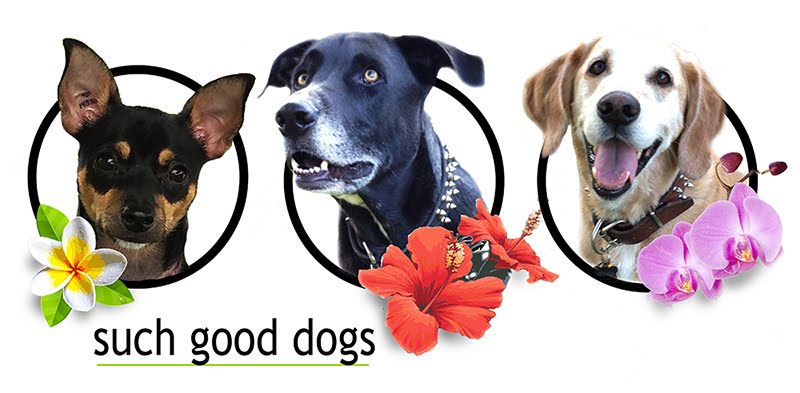Basic Manners -- Level One, Class #2
Such Good Dogs Basic Manners Class #2
Commands & Cues:
All commands or cue words like Sit and Come should be said ONE TIME and ONE TIME ONLY. Never repeat your command word. Instead give your No Reward Marker, move positions, and then try again.
Marker Word:
Use your chosen marker word: “Good” or “Yes” (or the Clicker).
This is the word (or sound) that says to a dog, “Yes! That is exactly what I wanted you to do!” and is then followed with a reward.
No Reward Marker:
This is what we do when the dog does not do what we are looking for. Try using an “Uh-oh” or “Eh-eh.” This will let the dog know that the behavior just performed is not what we wanted, while still encouraging the dog to continue to try. After using the NRM, physically move places (both you and the dog should move) to help “re-set” the training, then try again. Never repeat a command more than once.
Food Lure:
This is something we use to teach many new behaviors and commands. A food lure involves getting the dog to follow your baited hand into a desired position.
Look / Watch Me:
We want a dog who looks to us for direction and permission. Having a dog that is well focused on the owner will give you control over many situations. This is the exercise you will practice when your dog becomes distracted during training. This is meant to help focus (or re-focus) the dog back to the owner.
To do this, we place the treat directly in the dog’s nose then raise it straight up next to our eye, while standing back up. As you raise your hand give your command word, “Look.” Eventually we want the dog to look directly in our eyes, but to begin with, it they look anywhere in the general area of your head, say your “Good” and give the treat.
If your dog remains in position but is not looking at you, do NOT repeat your arm movements or verbal command. Instead, hold the treat in position next to your eye while looking at the dog and WAIT. You will wait 30 seconds to a minute. If the dog still has not looked, give your No Reward Marker or “Uh-oh,” move positions, take a breath, and then try again.
Watch a VIDEO teaching the "Look/ Watch Me" Cue in Basic Manners dog training class.
Watch a VIDEO teaching the "Look/ Watch Me" Cue in Basic Manners dog training class.
Come when Called:
The Rules:
1. Always have a leash (or fenced-in area).
2. When you say come, you have to see it happen.
3. NEVER punish a dog for coming to you.
The Steps:
- Say the dog’s name, and Come. ONE TIME ONLY.
- Have a party.
- Lure the dog back to you.
When first teaching a dog Come when called, we start with step 1 & 3. Standing directly in front of the dog (No distance), put the treat in the dog’s nose, say the dog’s name and Come (one time), then quickly back up a few steps. When the dog follows, stop, say “Good!” and give the treat. (Explained & Demonstrated in training.)
Loose Leash Walking:
Loose leash walking (LLW) means that a dog walks nicely, not pulling on the leash, and not completely all over the place. LLW is not the same thing as Heel. To teach a proper Heel, you must first teach LLW.
Consistency is very important when teaching LLW. Doing this technique is actually very easy, but does require a LOT of patience. Remember to stay calm. If you are calm and consistent, your dog will be walking nicely on a leash in about a week.
To begin, go out for a walk with your regular 4-6 foot leash and buckle collar properly fitted to your dog’s neck (so they can’t slip out). As soon as there is tension on the leash, you have two options:
When the dog pulls: 1) Stop and wait for the DOG to move in a way that releases the tension. When s/he does, continue walking.
2) Say “Let’s Go!” and walk off in the opposite direction.
It is best to try and do option #1 as much as possible. Be sure that when you stop and wait, you do not move in a way that is releasing the tension on the leash…the dog must do it.















